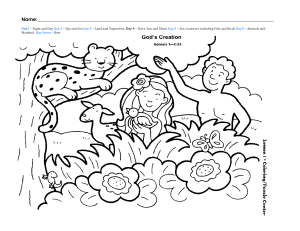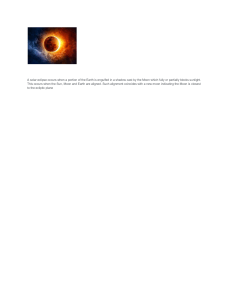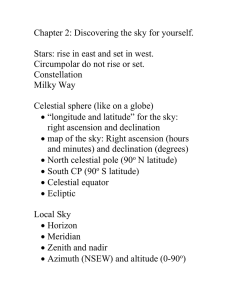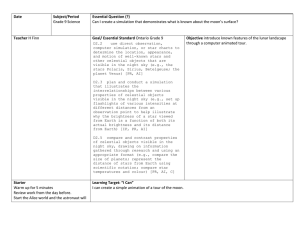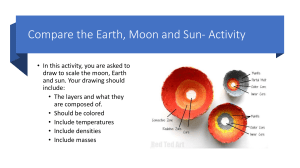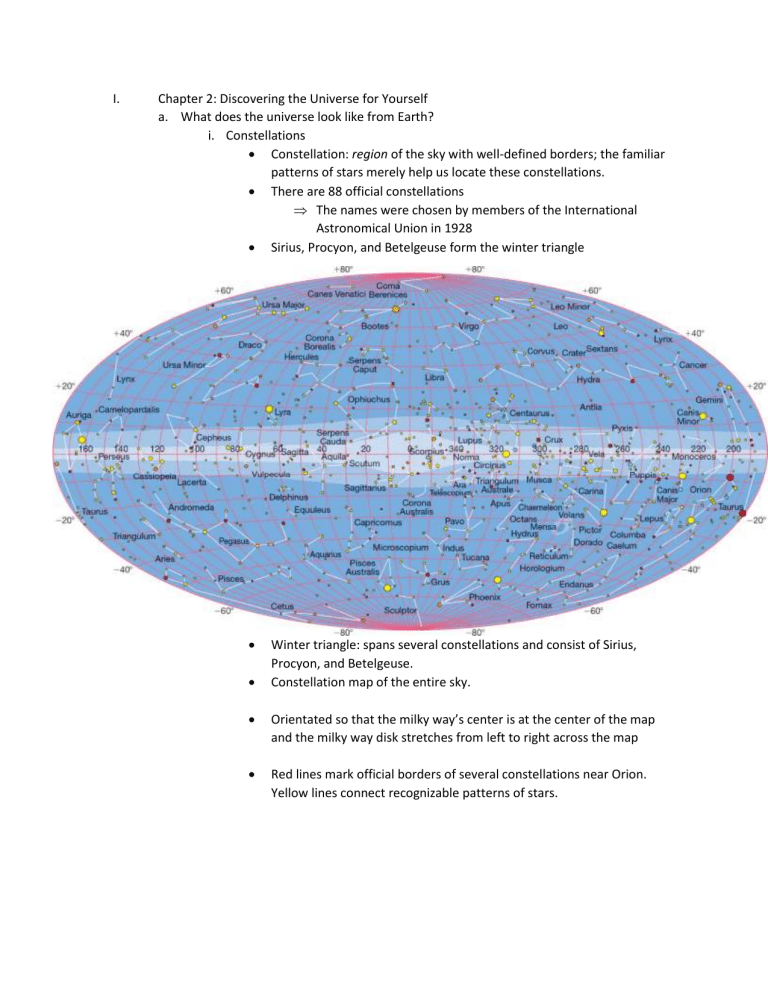
I. Chapter 2: Discovering the Universe for Yourself a. What does the universe look like from Earth? i. Constellations Constellation: region of the sky with well-defined borders; the familiar patterns of stars merely help us locate these constellations. There are 88 official constellations The names were chosen by members of the International Astronomical Union in 1928 Sirius, Procyon, and Betelgeuse form the winter triangle Winter triangle: spans several constellations and consist of Sirius, Procyon, and Betelgeuse. Constellation map of the entire sky. Orientated so that the milky way’s center is at the center of the map and the milky way disk stretches from left to right across the map Red lines mark official borders of several constellations near Orion. Yellow lines connect recognizable patterns of stars. Winter Triangle (looking south) on winter evenings from Northern Hemisphere. Star charts Round outside edge is the horizon Compass directions are marked in yellow Turn chart so the edge marked with the direction you’re facing is down The stars above this horizon now match the stars you are facing Center of chart is the sky overhead A star on the chart halfway from edge to the center is halfway from the horizon to straight up ii. The Celestial Sphere Some stars (in a constellation) might look like they’re really close to each other but they could actually be really far apart if they are at different distances from earth This illusion happens because we lack depth perception when it comes to space, because the stars are so far away. Ancient Greeks thought that the illusion was reality and thought that the stars and constellations are on a great celestial sphere that surrounds earth. Celestial Sphere: The imaginary sphere on which objects in the sky appear to reside when observed from Earth. They do not lie on a celestial sphere, they actually lie at different distances from earth. it is useful for mapping the sky though Allows us to map the sky as seen from earth. Earth is at the center of the sphere, in line with the horizontal celestial equator Because the center is where we are located as we look into space The north and south poles are at the top and bottom f the sphere A dotted line for the ecliptic runs diagonally and crosses the celestial equator. Two special circles and two points North celestial pole: the point directly over Earth’s North Pole. i I. Perpendicular to the plane the celestial equator lies South celestial pole: the point directly over earth’s south pole i I. Perpendicular to the plane the celestial equator lies. Celestial equator: a projection of earth’s equator into space, makes a complete circle around the celestial sphere i I. Lies in a place that passes through the equator of earth Ecliptic: the path the sun follows as it appears to circle around the celestial sphere once each year. It crosses the celestial equator at a 23 ½ degree angle, that it the tilt of earths axis. iii. The Milky Way Milky Way: a band of light that circles around the celestial sphere, passing though more than a dozen constellations, and bears an important relationship to the Milky Way galaxy It traces out galaxy's disk of stars, the galactic plane- as it appears from our location within the galaxy. Different than the Milky Way galaxy Our view in all directions into the disk of our galaxy our Galaxy is shaped like a thin pancake with butter in the middle. No matter where we look we see the stars and interstellar clouds that make up the milky way That is why the band of light makes a full circle around our sky The milky way appears wider in the direction of constellation Sagittarius because it’s in the direction of the central bulge of the galaxy We only have a clear view to the distant universe when we look away from the galactic plane Where there are fewer stars and clouds to block our view. The dark lanes that run down the center of the Milky Way contain the densest clouds These clouds have made it so we can’t see further than a few thousand light-years into our galaxy’s disk Because of this most of our galaxy has been hidden to us until new technology like radio waves, infrared light, and x-rays we're invented and allowed us to peer through the clouds by observing forms of light that are invisible to our eyes. iv. The Local Sky Local sky: the sky as seen from wherever you happen to be standing, looks like it takes the shape of a hemisphere or dome. The dome shape is because we can only see half of the celestial sphere at any point from one location The ground blocks the other half of the view. Horizon: boundary between earth and the sky Has an altitude of zero degrees Zenith: the point directly overhead Altitude is 90 degrees Has no direction because it is straight overhead. Lunar : an imaginary half-circle stretching from the south point on the horizon, through the zenith, to the north point on the horizon. We can pinpoint an object in the local sky by stating its altitude above the Horizon and direction along the horizon (Aka azimuth- degree clockwise from due north) Direction- one of the two coordinates (the other is altitude) needed to pinpoint an object in the local sky. It is the direction, such as north, south, east, or west, in which you must face to see the object. See also azimuth. Altitude- (above horizon) The angular distance between the horizon and an object in the sky. Above picture shows a person pointing to a star located in the southeast direction at an altitude of 60°. v. Angular Sizes and Distances Angular Size: a measure of the angle formed by extending imaginary lines outward from our eyes to span an object (or the space between two objects). The angle an object appears to span in your field of view We cant tell the true sizes or separations of objects in the sky because of our lack of depth perception. Angular size allows us to judge size without knowing how far away they are. The farther away an object is, the smaller its angular size. Sun: angular size of 1/2 degree Is about 400 times as large in diameter as the moon but it has the same angular size in our sky because it is about 400 times as far away Moon: angular size of 1/2 degree Three parts: Angular sizes of the sun and moon are about 1/2 degree The pointer stars that point at Polaris and the Big Dipper appear about 5 degrees part. The top and bottom stars of the southern cross appear about 6 degrees apart To estimate angular sizes or distances, stretch out your arm forward and above your head. At arm’s length, one finger spans about 1 degree, a hand with fingers spread spans about 20 degrees, and a fist spans about 10 degrees. Angular Distance: a measure of the angle formed by extending imaginary lines outward from our eyes to span an object (or space between two objects) Angle that appears to separate a pair of objects in the sky Pointer stars: angular distance between “pointer stars” at the end of the big dipper’s bowl is about 5 degrees Southern Cross: the angular length is about 6 degrees Arcminutes (Symbolized by ‘): 1/60 of 1 degree. used for greater precision for angular distance. Subdivide each degree into 60 arcminues and each arcminute into 60 arcseconds. Arcsecond (symbolized by “): see arcminutes. Example: 35 degrees 27’15” is read as 35 degrees, 27 arcminutes, 15 arcseconds. b. Why do stars rise and set? Stars move across the sky from east to west Ancient people thought this meant that we are in the center of the universe that rotates us every day. We now know that it is the opposite and earth rotates daily and not the universe. c. Common Misconceptions: the Moon Illusion The moon illusion: the full moon looks like its bigger when it is near the horizon than it is when it is high in the sky. This size change is the illusion made up by our brains. It is unknown why our brains do this. When compared to another object its angular size stays about the same throughout the night The moon’s angular size depends on its true size and distance The distance of the moon changes while it orbits but it does not change enough to make a noticeable effect on a single night. with the view of the celestial sphere it looks like every object on the sphere is making a daily circle around Earth. In the local sky it looks more complex because the horizon cuts the celestial sphere in half When looking at the figure of a typical Northern Hemisphere location (latitude 40 degrees north) there are 3 facts about the paths of stars through the sky. Circumpolar: a star that always remains above the horizon for a particular latitude. They circle counterclockwise around the north celestial pole every day. A star that is too far north to cross the plane of the observer’s horizon It’s daily circle is entirely above the horizon Stars near the south celestial pole never rise above the horizon at all Too far south to cross the plane of the observer’s horizon, always below the observer’s horizon and is never seen by that observer All other stars have daily circles that are partly above the horizon and partly below, which makes them appear to rise in the east and set in the west. There are four circles on the sphere in the figure that show the paths of stars due to Earth’s rotation. Earths rotation is drawn with a black arrow Two circles are on the northern half of the sphere Two circles are on the southern half of the sphere i i. These circles are parallel to the celestial equator ii Ii. They show that stars on the celestial sphere appear to rotate parallel to the celestial equator Stars also look like they move in circles around the north and south celestial poles. The horizon slices through the celestial sphere at an angle to the celestial equator, causing the daily circles of stars to appear tilted in the local sky. Observer’s horizon is tilted 40 degrees with respect to the celestial equator Horizon circle defines a plane dividing th sphere diagonally A line perpendicular to this plane points to the observer’s zenith It is easier to follow star paths if you rotate the page so that the zenith points up. Time exposure photograph at the beginning of the chapter shows a part of the daily paths of stars. The paths of circumpolar stars are visible within the arch The daily circles for these stars are above the horizon but the picture only shows a portion of the circle. The north celestial pole is at the center of the circles The larger the circle, the further from the north celestial pole the star is If the circles are large enough (far enough from the north celestial pole) it will cross the horizon so that the stars rise in the east and set in the west The same idea for the southern hemisphere. The circumpolar stars are near the south celestial pole They circle clockwise instead of couterclockwise Earths west to east rotation makes stars appear to move from east to west through the sky as they circle around the celestial poles d. Why do the constellations we see depend on latitude and time of year? Angular size, physical size, and distance. Hold a coin in front of one eye and it blocks your view. Move it further away and it appears smaller and blocks less of your view. As long as an object is far enough away so that its angular size is small (less than a few degrees), this formula relates the object’s angular size (in degrees), physical size, and distance: Angular size/360 degrees = physical size/ 2(pi) x distance Ex: the moon’s angular diameter is about 0.5 degrees and its distance is about 380,000 km. What is the moon’s physical diameter? i i. Physical size= angular size x ((2pi x distance)/360 degrees) ii ii. Plug in moons angular size and distance iii iii. physical size= 0.5degrees x( (2pi x 380,000km)/360 degrees) = 3300km the moons diameter is about 3300 km. the exact value (3476km) would be found by using more exact values Variation with Latitude Latitude- measures north-south position on earth. 0degrees at the equator, 90degreesN at the north pole, 90degreesS at the south pole. 0degrees along the prime meridian Prime meridian- the meridian of longitude that passes through Greenwich, England; defined to be longitude 0degrees. Longitude- measures east-west position on earth Latitude + longitude pinpoints a location on earth i i. ex: Miami is about 26degreeN latitude and 80degreeW longitude. Latitude affects the constellations we see because it affects the locations of the horizon and zenith relative to the celestial sphere. The sky does not vary with longitude though i i. ex: Charleston, SC and San diego, CA are about the same latitude so they see the same set of constellations. The picture below shoes how this works for the latitudes of the north pole (90degreeN) and Sydney, Australian (34degreeS) North Pole: can only see what lies on the northern half of the celestial sphere and they are all circumpolar i i. why the sun remains above the horizon for 6 months. It circles the sky at the north pole just like a circumpolar star. The altitude of the celestial pole in your sky is equal to your altitude i i. ex: if the north celestial pole has an altitude of 40degrees above your north horizon, your latitude is 40degreeN. Finding the north celestial pole is easy because it lies close to the north star Polaris In the southern hemisphere you can find the south celestial pole by using the southern cross. e. Common misconceptions: star in the daytime Stars do not vanish at night and come out during the day Stars are always out but their dim light gets overwhelmed by the bright light of the sun You can see stars during the day with a telescope or during a total eclipse Astronauts can see stars during the daytime above earth’s atmosphere where there is no air to scatter sunlight The sun is so bright that astronauts must block its light to see the stars. ii. Variation with time of year The night sky changes throughout the year because earth is changing position while orbiting the sun The annual orbit of earth makes the sun look like its moving steadily eastward along the ecliptic with stars of different constellations at different times of the year Zodiac: the constellations on the celestial sphere through which the ecliptic passes. Traditionally there are 12 constellations along the zodiac but with the official borders there a thirteenth constellation called Ophiuchus. Ophiuchus: the 13th constellation of zodiac There’s a different background of zodiac constellations at different times of the year August 21: sun appears to be in leo but we cannot see leo because it is in the daytime sky. But at this time we can see aquarius because its in the opposite location from leo on the celestial sphere In February we see leo because aquarius is in the day time sky f. II. Common misconceptions: what makes the north star special? Polaris is not the brightest star in the sky There are more than 50 other stars that are just as bright or brighter It is special because it is close to the north celestial pole and useful for navigation The Reason for seasons a. What causes the seasons? seasons are caused by the combination of earths rotation and orbit the tilt of earths axis causes sunlight to fall differently on earth at different times of year Step 1: (for the picture above) the tilt of the earths axis remains pointed towards Polaris throughout the year The orientation of the axis relative to the sun changes over the course of each orbit Northern hemisphere is tipped toward the sun in June and away in December In the southern hemisphere is tipped toward the sun in December and away from the sun in June. Step 2: ( for the picture above) earth in June the axis tilt causes sunlight to strike the northern hemisphere at a steeper angle and southern hemisphere at a shallower angel This makes it summer in the northern hemisphere Steeper angle means more concentration of sunlight and makes it warmer Steeper angle also means more hours of daylight (while its being warmed by the sun) because earths rotation means the sun follows a longer and higher path through the sky This makes it winter in the southern hemisphere Shallower sunlight angle means a lower concentration of sun and a shorter, lower path through the sky (for the sun) Step 3: (in the picture above) both hemispheres are illuminated equally in march and September. Making it spring for the hemisphere that is on the way from winter to summer and fall for the hemisphere moving from summer to winter. Step 4: (in the picture above) shows that it has become winter in the northern hemisphere and summer for southern hemisphere Seasons are not affected by the distance between earth and the sun At its furthest distance the earth is only 3% farther from the sun (in July) than it is in the nearest (January) The difference made by the strength of sunlight due to change in distance is overwhelmed by effects caused by the axis tilt If earth did not have axis tilt we would not have seasons. Jupiter has small axis tile of about 3degree Saturn has axis tilt of about 27degree Both planets have almost circular orbits around the sun b. Common Misconceptions: The Cause of Seasons earths varying orbital distance has no effect on the weather ii. Solstices and Equinoxes There are four special moment in the year that correspond to one of four special positions in earth’s orbit. They help us mark the seasons June solstice: summer solstice in the northern hemisphere occurs around June 21 The moment when the northern hemisphere is tipped most directly toward the sun and gets the most direct sunlight December solstice: winter solstice in northern hemisphere around December 21st When northern hemisphere gets the least amount of sunlight March equinox: spring (vernal) equinox in the northern hemisphere around march 21st When northern hemisphere moves from tipped slightly away from the sun to slightly toward the sun. September equinox: fall (autumnal) equinox in northern hemisphere around September 22 When northern hemisphere starts to tip away from the sun Dates and times of solstices and equinoxes may vary by a couple of days from above dates Leap years add one day on feb 29 every four years Modern calendars include leap years to keep the solstices and equinoxes around the same days Leap year pattern based on fact that the true length of the year is close to 365 ¼ days. (referring to tropical year) Tropical year: time from one march equinox to the next Axis precession causes the tropical year to be slightly shorter (by about 20 mins) than earth’s orbital period Sidereal year: earth’s orbital period Equinoxes and solstices are marked by observing changes in the sun’s path through the sky Equinox: during the only two days of the year when the sun rises exactly due east and sets exactly due west Also the days when the sun is above and below the horizon for the same time of 12 hours Means equal night June Solstice: on the day the sun follows its longest and highest path through the northern hemisphere sky and shortest and lowest path through the southern hemisphere sky When the sun rises and sets farthest to the north of due east and due west Day when northern hemisphere has the most hours of daylight and the sun is the highest in the midday sky December solstice: the sun rises and sets farthest to the south Northern hemisphere has least hours of daylight and lowest midday sun First photo shows suns path for solstices and equinoxes for northern hemisphere sky (latitude 40degreeN). Paths are different for different latitudes Latitude 40degreeS paths look similar but are tilted to the north instead of the south Second photo shows images of the sun taken in 7 to 11 day intervals over a year at the same mean solar time and in the same spot in the northern hemisphere Photo looks eastward so north is to the left and south to the right Images that are high to the north shoe a time near June solstice Image that are low and south are near December solstice Analemma: the figure 9 shape created by the photos i Happen from a combination of earths axis tilt and earths varying speed as it orbits the sun iii. Special Topic: How long is a day? A rotation period is actually 23 hours and 56 minutes (23 hours, 56m, 4.09 seconds), 4 minutes short of the 24 hours we think of Sidereal day: (sy-dear-ee-al) means related to the stars. The time it takes any star to make one full circuit through our sky Solar day: our 24 hour day. The average time it takes the sun to make one circuit through the sky Explanation: point at an object that represents the sun and an object behind it that represents a star. Stand a few steps away to represent earth. Rotate counterclockwise while standing in place and you will point at both the sun and the star at the same time again. But the earth also orbits the sun. Sidereal day: take a couple of steps around the sun as you rotate counterclockwise. One full rotation and you will be pointing at the distant star Solar day: you have to rotate a little extra to point back at the sun. this extra rotation makes the solar day longer Figure out how long the extra rotation takes Earth does a full 360degree around the sun in about 365 days, a rate of about 1 degree per day Extra rotation takes about 1/360 of earths rotation period, about 4 minutes. iv. First Days of Seasons Equinox and solstice is said to mark the first day of a season June solstice is the first day of summer but in the northern hemisphere it has its max tilt toward the sun Why is it the first of summer instead of the midpoint of summer? 1. It was easier for ancient people to recognize the highest point as summer solstice than days in between 2. We think of seasons in terms of weather. Warmest weather takes 1-2 months after solstice because it takes a while for the sun to reach and warm the earth Midsummer in terms of weather would be in late July and early august making June a good choice for first day of summer v. Seasons around the world Seasons are different around the world because of different latitudes. High latitudes have more extreme seasons Vermont has longer summer days and longer winter nights than florida Artic circle (latitude 66 ½) the sun is out all day on the june solstice and never rises on December solstice “what you actually see is also affected by the fact that the atmosphere bends sunlight, so that the sun can appear to be above the horizon even when it is actually slightly below it) This shows the progression of the sun around the horizon on June solstice in the artic circle. The sun skims the northern horizon at midnight, slowly rises higher, its highest point when due south at noon Seasons are also different in the equatorial regions They get the most direct sunlight on the equinoxes and least on the solstices They tend to have rainy and dry seasons instead of the four seasons that higher latitudes experience Rainy seasons come when the sun is higher in the sky c. Common Misconceptions: High Noon High noon: highest point the sun is in the sky each day when it crosses the meridian (rarely at exactly noon) If you don’t live in the tropics (between latitudes 23.5degreeS and 23.5degreeN) the sun is never directly overhead d. How does the orientation of Earths axis change with time? The constellations associated with the solstices and equinoxes change slowly over time Precession: the gradual wobble of the axis of a rotating object around a vertical line. Alters the orientation of earths axis in space When spinning a top its axis will sweep out circles at a slower rate The top axis processes Earth does this more slowly A cycle of earths procession take about 26,000 years Changes direction the axis points in space Affects orientation of axis, not the amount of tilt Tilt is about 23 ½ degrees And doesn’t affect pattern of the seasons Changes point in earths orbit that solstices and equinoxes happen and changes the constellations that are seen at those times Caused by gravity Earth gravity tries to pull over the lopsided, tilted spin axis but precesses the axis instead Gravity from sun and moon try to straighten out earths equator, which has the same tilt as the axis Ex: thousands of ears ago the June solstice happened when the sun was in the constellation cancer, now it happens when the sun is in gemini This explains why the latitude the sun is directly overhead on the June solstice (23 1/2degreeN) on a map is called the tropic of cancer e. Common Misconceptions: Sun Signs. Astrology began a few thousand years ago III. Sun signs are supposed represent the constellation that the sun appeared on your birth date Procession makes it so that is no longer the case for most These signs are based on the positions of the sun among the stars that were almost 2000 years ago Earths axis has moved about 1/13 through its 26,000 year precession sine then, the sun signs are off by almost a month from the actual position of the sun and constellations today Ex: march 21 sun sign is aries but the sun is now in pisces The Moon, Our Constant Companion a. Why do we see phases of the moon? The moon is the brightest and most noticeable object in the sky (except for the sun) and orbits with us around the sun The moon orbits the earth and returns to the same position relative to the sun (the earth-sun line) about every 29 ½ days Lunar Phases: the time the moon takes to orbit the earth. The appearance of the moon changes as its position to the sun changes Month (moonth): originated from the 29 ½ day period of the moon The cycle of phases is about 2 days longer than the moons orbital period (27 1/3 days) because of earths motion around the sun. the reason is the same as why the solar day is longer than the sidereal day ii. Understanding phases Sunlight comes to both earth and the moon from about the same direction Two basic facts about the lunar phases 1. Half of the boon always faces the sun and is bright and the other half always faces away and is dark 2. When you look at the moon in different positions of its orbit, you see different combinations of bright and dark faces The new moon is in line with the sun and hidden in the bright daytime sky Moon phase determines when we will see it Full moon will rise around sunset because it is opposite the sun Reaches highest point at midnight and sets around sunrise First-quarter moon: rise around noon, reach high point around sunset, set around midnight Is when the moon is 90degree east of the sun Waxing: phases from new to full. Means increasing There is no half moon phase First-quarter: we see half moon, one quarter through monthly cycle Third-quarter: half moon, three quarter through monthly cycle, a week after full moon New cycle stars at new moon Crescent: phases just before and after new moon Gibbous: (hard g “gift”) phases just before and after full moon iii. The moon’s synchronous Rotation Synchronous rotation: the rotation of an object that always shows the same face to an object that it is orbiting because its rotation period and orbital period are equal Moon rotates o axis in same time it orbits earth This happens because of earths gravity in the same way the moons gravity causes tides on earth. Because we see the same face of the moon means the moon must rotate only once during its orbit around earth iv. The view from the moon If on the moon during a new moon you would see a full earth because the moon is between the sun and earth so it would be daytime on earth. On a full moon you would see the night side of earth, a new earth If on the moon looking at the earth, you will always see the opposite phase from the moon b. Common Misconceptions: Shadow and the Moon It is thought that the moons phases are caused by earths shadow falling on it Moons phases are actually caused by the different portions of its day and night sides at different times as it orbits earth A lunar eclipse is the only time earths shadow will fall on the moon c. Common Misconceptions: moon in the daytime The moon is not only out during the night. It is out almost as long during the day than it is during night. We can see the moon only when the light of the sun isn’t drowning it out During a first quarter moon we can see the moon in the late afternoon as it rises through eastern sky Third-quarter moon is visible in the morning as it heads toward western horizon d. What Causes Eclipses? Two basic types of eclipse Lunar eclipse: when earth comes directly between the sun and the moon and earths shadow falls on the moon Because the earth is so much bigger than the moon, its shadow can cover the entire moon Can be seen by anyone on the night side of the earth when it happens Solar eclipse: when the moon comes directly between the sun and earth and the moons shadow falls on earth. The moon is a lot smaller than earth so its shadow can only cover a portion of earth when it happens You must be in the narrow pathway that the shadow moves in order to see it i this is why we tend to see lunar eclipses more even though they happen almost as often ii. Shadow regions A shadow consists of two regions: Full shadow: (umbra) the dark central region of a shadow. Sunlight is fully blocked Partial shadow: (penumbra) the lighter, outlying regions of a shadow. Light from only part of the sun is blocked iii. Lunar Eclipses Begins when the moons orbit first carries it into earths partial shadow Three types of lunar eclipses that can happen after that: Total Lunar Eclipse: a lunar eclipse in which the moon becomes fully covered by earths full shadow. When the sun, earth, and moon are nearly perfectly aligned. The moon passes through earths full shadow The most spectacular The moon turns dark and red during totality Partial Lunar eclipse: a lunar eclipse during which the moon becomes only partially covered by Earth’s full shadow. Alignment between the sun, earth, and moon is less perfect, only part of full moon passes through earths full shadow (with the rest in partial shadow) Penumbral lunar eclipse: when the moon passes only through earths partial shadow. These are the most common and least impressive because the full moon only slightly darkens. Totality: the portion of a total lunar eclipse during which the moon is fully within the earths full shadow or a total solar eclipse during which the suns disk is fully blocked by the moon. The moon becomes dark and red Lasts about an hour with partial phases before and after Earth projects shadow with curvature which proves earth is round during the partial phases iv. Solar Eclipses Three types of solar eclipse Total solar eclipse: a solar eclipse during which the sun becomes fully blocked by the disk of the moon When the moon is in part of its orbit and close to earth, full shadow will cover small part of earth (up to about 270km in diameter) The moon slowly creeps in and takes over the moon. It becomes dark and temperature drops. Animals go to their homes and crickets will chirp Corona: when the moon completely blocks the visible sun showing a corona It takes the sun a couple of ours to come back out but because we get used to the darkness, it seems a lot faster than that Annular Eclipse: when the moon is its orbit and further from earth, all of the shadow might not reach earths surface A ring of sunlight surrounding the moon, in the small region of earth directly behind the full shadow For either one the region of totality or annularity will be surrounded by a much larger region (about 7000 km in diameter) that falls within the moons partial shadow Partial solar eclipse: a solar eclipse during which the sun becomes only partially blocked by the disk of the moon Because of earth rotating and moon orbiting, the shadow races across earth (about 1700km an hours) and totality never lasts longer than a few minutes in any particular place 2017 solar eclipse in green river lakes, Wyoming lasted about 2 minutes v. Conditions for eclipses We don’t have as many solar or lunar eclipses as one would think while looking at the sun, moon, and earths orbit because the moons orbit is inclined about 5degree to the ecliptic plane During the moons orbital inclination the moon spends most time above or below the ecliptic plane Nodes: when the moon crosses through the ecliptic place, once coming out and once going back in Lined about the same way all year, they have almost a straight line with the sun and earth about 2x a year. Eclipse seasons: only time an eclipse can happen, last an average of 5 weeks Lasts a few days longer than a cycle of phases Happen about 2x a year Each season has a lunar eclipse and solar eclipse An eclipse can happen when: The moon is full (for lunar eclipse) or new (for solar eclipse) and The new or full moon happens when the moon is close to a node, during an eclipse season There is always a lunar eclipse at full moon and solar eclipse at new moon during each eclipse season. A second eclipse can happen during an eclipse season vi. Predicting eclipses The nodes slowly move around the moons orbit causing the eclipse season to happen a little less than 6 months apart (173 days) Saros Cycle: the period over which the basic pattern of eclipses repeats, which is about 18 years, 11 1/3 days. Saros cycle is caused by the changing dates of eclipse season and the 29 1/3 day lunar phases cycle Astronomers today can predict when an eclipse will happen and what kind it will be because we know about the orbits of earth and the moon. Lunar eclipses 2021-2025 in universal time (Greenwich, England) Date May 26, 2021 Type Total Nov. 19, 2021 May 16,2022 Nov. 8, 2022 May 5, 023 Oct. 28, 2023 Mar. 25, 2024 Sept. 18, 2024 Mar. 14, 2025 Sep. 7, 2025 Partial Total Total Penumbral Partial Penumbral Partial Total Total IV. Where you can see it Australia, pacific, western Americas Asia, Australia, pacific, Americas Americas, Europe, Africa Asia, Australia, pacific, Americas Europe, Africa, asia, Australia Europe, Africa, asia, Australia Asia, Australia, pacific, Americas Americas, Europe, Africa Americas, western Africa Europe, Africa, asia australia Shows the path of totality for solar eclipses from 2017-2045 Next total solar eclipse for the us is April 8, 2024 e. Common Misconceptions: the “dark side” of the moon Far side of the sun is not always dark New moon the far side faces the sun and is completely lit Since moon rotates in about a month, that means points on both near and far side of the moon alter between 2 weeks of light and 2 weeks of darkness Only time the far side is completely dark is during a full moon since it faces away from both the sun and earth The Ancient Mystery of the Planets There are five planets that are easy to see with the naked eye Mercury: visible infrequently, only right after sunset or before sunrise. Because it’s close to the sun Venus: bright in the early evening toward the west or before dawn in the east Jupiter: when it’s visible it’s the brightest thing in the sky except for the moon and venus Mars: can be seen by its red color. Make sure you’re not just looking at a red star Saturn: other stars are just as bright as Saturn so you have to know where to look Planets do not twinkle as much as stars a. Why was planetary motion so hard to explain? Planet: from a Greek term meaning “wandering star” Planet’s don’t simply rise in east and set west like stars do Planets vary in speed and brightness Planets usually move eastward through constellations but sometimes they go backward through the zodiac Apparent Retrograde Motion: the apparent motion of a planet, as viewed from earth, during the period of a few weeks or months when it moves westward relative to the stars in our sky. It goes backwards through the zodiacs Time depends on the planet Planets do not actually change direction, they only look like they do because earth orbits faster than they do. It looks like they’re going backwards relative to the stars when earth passes it People who believed in earth-centered universe had a hard time explaining apparent retrograde motion and came up with some crazy explanations how could the planets sometimes turn around if everything revolves around the earth? b. Why did the ancient greeks reject the real explanation for planetary motion? A Greek astronomer Aristarchus of Samos suggested that the earth revolves around the sun in 260 B.C. We don’t know how or why he came up with this idea It was rejected by his “contemporaries” It wasn’t accepted until almost 2000 years later. Stellar parallax: the apparent shift in the position of a nearby star (relative to distant objects) that occurs as we view the star from different positions in Earth’s orbit of the Sun each year. Think of your two eyes as earth on opposite sides of its orbit. Think of your finger as a nearby star We view stars from different places in our orbit at different times of the year Nearby stars should look like they shift back and forth against the background of more distant stars The amount of shift is too small to see with the naked eye Can be seen with telescopes Proves earth orbits the sun Gives the most reliable measurement of distances to nearby stars. Parallax: happens when your eyes view something from opposite sides of your nose Ex: hold your finger out in front of you and look at it while closing one eye at a time. The closer the object is, the worse the parallax is The greeks had trouble seeing a sun centered universe because they couldn’t see stellar parallax. They knew it should happen but couldn’t detect it. “seeing is believing” The greeks believed in a celestial sphere so they though stellar parallax would look different because stars lie in one spot They thought that if earth obits the sun they thought that at different times of year we would be closer to different parts of the celestial sphere and notices changes in the angular separations of stars Their conclusions: Earth orbits the sun but the stars are too far away to see stellar parallax. Or There is no stellar parallax because earth stays still in the center of the universe. They rejected the first (and correct) answer because they couldn’t imagine the stars being that far away. c. The Big Picture: Putting Chapter 2 into Perspective i. It is easy to think we are in the center of a celestial sphere but we are actually a planet orbiting a star (sun). We can understand the things we see in the local sky by looking at the latitude of the celestial sphere
